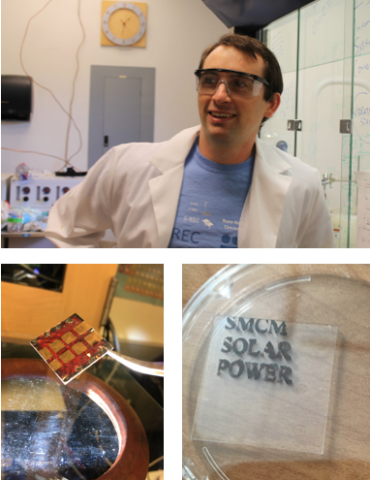
Solar energy startup company SolarCube LLC has won a $100,000 technology product development grant through the Maryland Industrial Partnerships Program (MIPS). The funding will directly support the research and development work led by Troy Townsend, assistant professor of chemistry at St. Mary’s College of Maryland (SMCM), who is the principle inventor for technology that uses nanomaterials to allow photovoltaic solar modules to be manufactured using an affordable, inkjet-like printing process.
MIPS, a program of the Maryland Technology Enterprise Institute (Mtech) in the A. James Clark School of Engineering at the University of Maryland, supports research projects at University System of Maryland universities (plus Morgan State University and St. Mary’s College), to help Maryland companies develop technology-based products. MIPS funds are matched by participating companies to pay for the university research.
Solar Cube’s MIPS project is also supported by the Maryland Department of Natural Resources (DNR) Innovative Technology Fund, a partnership between DNR, the University of Maryland and the U.S. Environmental Protection Agency, with the goal of accelerating Chesapeake Bay restoration through the development of new technologies. DNR provided funding to MIPS for the project.
Townsend developed the base technology at the U.S. Naval Research Laboratory in 2014 and has proven the process with a working nanocrystal prototype. In June 2018, SolarCube LLC and the Naval Research Laboratory signed the license agreement for the lab’s patented “spray deposition method for inorganic nanocrystal solar cells” technology. TechLink, the Department of Defense’s national partnership intermediary, assisted SolarCube with development of the required commercialization plan and patent license application.
“Of all the renewable energy options, solar is the only one with enough potential to exceed even our future global power demand,” Townsend said. “Solar power is a really nice financial benefit for homeowners. But not for everyone else. In order to make it more accessible, we need to drive the price way down and seamlessly integrate it into our everyday life.”
Townsend’s work on printed electronics involves undergraduate research at St. Mary’s College. Student Bradley Moore ’20, who works on printing the nanocrystal inks said, “If we do the layers correctly, it will make a solar panel that would be 40 times thinner than a human hair.” Moore injects inks made of semiconducting and metallic nanocrystals into cartridges to print out 2D patterns onto arbitrary substrates to build electronics.
Moore works with fellow student Megan Waters ’20, who is synthesizing the inks using air-free conditions. Waters, who has been synthesizing silver nanowires said, “Trying to figure out just the right concentrations and times of injection were definitely the most challenging and interesting parts of the synthesis.”
Townsend said, “Undergraduate research is our pride and joy here at St. Mary’s College. These projects would not be possible without our talented students. In the meantime, they are working on graduate level projects and publishing their work in journals and presenting at national conferences.” Townsend was also co-director of the 2019 St. Mary’s Undergraduate Research Fellowship, which provided opportunities for students to work on mentored projects over the summer.
Townsend’s research group will continue to work with SolarCube LLC to develop printed solar cells. SolarCube LLC is located at the TechPort incubator in California, Maryland. Townsend plans to print a prototype solar module using the support of the MIPS award and work with SolarCube LLC on ways to adapt the lab-scale process into industrial-scale printing-press manufacturing.
Townsend said, “Just like the printing press revolutionized the written word, rapid roll-to-roll printing of electronics is the next step.”
For more information about the project, please visit TEDx Leornardtown video. https://www.youtube.com/watch?v=ivV1w2GFcmE&feature=youtu.be



